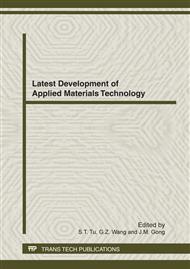[1]
J. van der Geer, J.A.J. Hanraads, R.A. Lupton, The art of writing a scientific article, J. Sci. Commun. 163 (2000) 51-59.
Google Scholar
[2]
X.W. Lou, Y. Wang, C.L. Yuan, J.Y. Lee, L.A. Archer. Template-Free Synthesis of SnO2 Hollow Nanostructures with High Lithium Storage Capacity, Adv. Mater. 18 (2006) 2325-2329.
DOI: 10.1002/adma.200600733
Google Scholar
[3]
X.W. Lou, C.M. Li, L.A. Archer. Designed Synthesis of Coaxial SnO2@carbon Hollow Nanospheres for Highly Reversible Lithium Storage, Adv. Mater. 21 (2009) 2536-2539.
DOI: 10.1002/adma.200803439
Google Scholar
[4]
J. Liu, H. Xia, D.F. Xue, L. Lu. Double-Shelled Nanocapsules of V2O5-Based Composites as High-Performance Anode and Cathode Materials for Li Ion Batteries, J. Am.Chem.Soc. 131 (2009) 12086-12087.
DOI: 10.1021/ja9053256
Google Scholar
[5]
Y.M. Kang, M.S. Song, J.H. Kim, H.S. Kim, M.S. Park. A study on the charge-discharge mechanism of Co3O4 as an anode for the Li ion secondary battery, Electrochim. Acta. 50 (2005) 3667-3673.
DOI: 10.1016/j.electacta.2005.01.012
Google Scholar
[6]
J. Chen, L.N. Xu, W.Y. Li, X.L. Gou. Alpha-Fe2O3 Nanotubes in Gas Sensor and Lithium-Ion Battery Applications, Adv. Mater. 17 (2005) 582-586.
DOI: 10.1002/adma.200401101
Google Scholar
[7]
Y.N. Nuli, S.L. Zhao, Q.Z. Qin. Nanocrystalline tin oxides and nickel oxide film anodes for Li-ion batteries, J. Power Sources. 114 (2003) 113-120.
DOI: 10.1016/s0378-7753(02)00531-1
Google Scholar
[8]
S.A. Needham, G.X. Wang, H.K. Liu. Synthesis of NiO nanotubes for use as negative electrodes in lithium ion batteries, J. Power Sources. 159 (2006) 254-257.
DOI: 10.1016/j.jpowsour.2006.04.025
Google Scholar
[9]
P. Poizot, S. Laruelle, S. Grugeon, L. Dupont, J.M. Tarascon. Nano-sized transition-metal oxides as negative-electrode materials for lithium-ion batteries, Nature 407 (2000) 496-499.
DOI: 10.1038/35035045
Google Scholar
[10]
B. Laik, P. Poizot, J.M. Tarascon. The Electrochemical Quartz Crystal Microbalance as a Means for Studying the Reactivity of Cu2O toward Lithium, J.Electrochem.Soc. 149 (2002) A251-A255.
DOI: 10.1149/1.1445430
Google Scholar
[11]
M.Z. Wei, N. Lun, X.C. Ma, S.L. Wen. A simple solvothermal reduction route to copper and cuprous oxide, Mater.Lett. 61 (2007) 2147-2150.
DOI: 10.1016/j.matlet.2006.08.035
Google Scholar
[12]
J.H. Lee, S.K. Hong, W.B. Ko. Synthesis of cuprous oxide using sodium borohydride under microwave irradiation and catalytic effects, J. Ind. Eng. Chem. 16 (2010) 564-566.
DOI: 10.1016/j.jiec.2010.03.019
Google Scholar
[13]
J.Y. Xiang, J.P. Tu, Y.F. Yuan, X.H. Huang, Y. Zhou, L. Zhang. Improved electrochemical performances of core-shell Cu2O/Cu composite prepared by a simple one-step method, Electrochem. Commun. 11 (2009) 262-265.
DOI: 10.1016/j.elecom.2008.11.029
Google Scholar
[14]
M. Yang, X.Y. Zhao, L.Q. Ma, Y. Yao, Y. Ding, X.D. Shen. Electrochemical properties of Cu2O/Cu composite particles prepared by a novel and facile method, Electrochim. Acta. 56 (2011) 5783-5787.
DOI: 10.1016/j.electacta.2011.04.061
Google Scholar
[15]
F. Gillot, M.P. Bichat, F. Favier, M. Morcrette, M.L. Doublet. The Li(x)MPn(4) phases (M/Pn = Ti/P, V/As): new negative electrode materials for lithium ion rechargeable batteries, Electrochim.Acta. 49 (2004) 2325-2332.
DOI: 10.1016/j.electacta.2004.01.013
Google Scholar
[16]
S. Grugeon, S. Laruelle, R. Herrera-Urbina, L. Dupont, P. Poizot, J.M. Tarascon. Particle Size Effects on the Electrochemical Performance of Copper Oxides toward Lithium, J. Electrochem.Soc. 148 (2001) A285-A292.
DOI: 10.1149/1.1353566
Google Scholar
[17]
A. Debart, L. Dupont, P. Poizot, J.B. Leriche, J.M. Tarascon. A Transmission Electron Microscopy Study of the Reactivity Mechanism of Tailor-Made CuO Particles toward Lithium, J.Electrochem.Soc. 148 (2001) A1266-A1274.
DOI: 10.1149/1.1409971
Google Scholar
[18]
H.C. Liu, S.K. Yen. Characterization of electrolytic Co3O4 thin films as anodes for lithium-ion batteries, J. Power Sources. 166 (2007) 478-484.
DOI: 10.1016/j.jpowsour.2007.01.072
Google Scholar
[19]
J. Shu, M. Shui, F.T. Huang, D. Xu, Y.L. Ren, L. Hou, J. Cui, J.J. Xu. Comparative study on surface behaviors of copper current collector in electrolyte for lithium-ion batteries, Electrochim. Acta. 56 (2011) 3006-3014.
DOI: 10.1016/j.electacta.2011.01.004
Google Scholar


